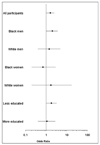Incarceration, incident hypertension, and access to health care: findings from the coronary artery risk development in young adults (CARDIA) study
- PMID: 19364998
- PMCID: PMC2829673
- DOI: 10.1001/archinternmed.2009.26
Incarceration, incident hypertension, and access to health care: findings from the coronary artery risk development in young adults (CARDIA) study
Abstract
Background: Incarceration is associated with increased cardiovascular disease mortality, but prospective studies exploring mechanisms of this association are lacking.
Methods: We examined the independent association of prior incarceration with incident hypertension, diabetes, and dyslipidemia using the Coronary Artery Risk Development in Young Adults (CARDIA) study-a cohort of young adults aged 18 to 30 years at enrollment in 1985-1986, balanced by sex, race (black and white), and education (high school education or less). We also examined the association of incarceration with left ventricular hypertrophy on echocardiography and with barriers to health care access.
Results: Of 4350 participants, 288 (7%) reported previous incarceration. Incident hypertension in young adulthood was more common among former inmates than in those without incarceration history (12% vs 7%; odds ratio, 1.7 [95% confidence interval {CI}, 1.2-2.6]), and this association persisted after adjustment for smoking, alcohol and illicit drug use, and family income (adjusted odds ratio [AOR], 1.6 [95% CI, 1.0-2.6]). Incarceration was significantly associated with incident hypertension in those groups with the highest prevalence of prior incarceration, ie, black men (AOR, 1.9 [95% CI, 1.1-3.5]) and less-educated participants (AOR, 4.0 [95% CI, 1.0-17.3]). Former inmates were more likely to have left ventricular hypertrophy (AOR, 2.7, [95% CI, 0.9-7.9]) and to report no regular source for medical care (AOR, 2.5, [95% CI, 1.3-4.8]). Cholesterol levels and diabetes rates did not differ by history of incarceration.
Conclusions: Incarceration is associated with future hypertension and left ventricular hypertrophy among young adults. Identification and treatment of hypertension may be important in reducing cardiovascular disease risk among formerly incarcerated individuals.
Figures

References
-
- Trust TPC. One in 100: Behind Bars in America. 2008
-
- Olubodun J. Prison life and the blood pressure of the inmates of a developing community prison. J Hum Hypertens. 1996 Apr;10(4):235–238. - PubMed
-
- Cutter GR, Burke GL, Dyer AR, et al. Cardiovascular risk factors in young adults. The CARDIA baseline monograph. Control Clin Trials. 1991 Feb;12 1 Suppl:1S–77S. - PubMed
-
- Alcoholism NIoAAa. National Institute on Alcohol Abuse and Alcoholism, Helping Patients Who Drink Too Much: A Clinician's Guide. 2008. http://pubs.niaaa.nih.gov/publications/Practitioner/CliniciansGuide2005/....
Publication types
MeSH terms
Grants and funding
LinkOut - more resources
Full Text Sources
Medical

